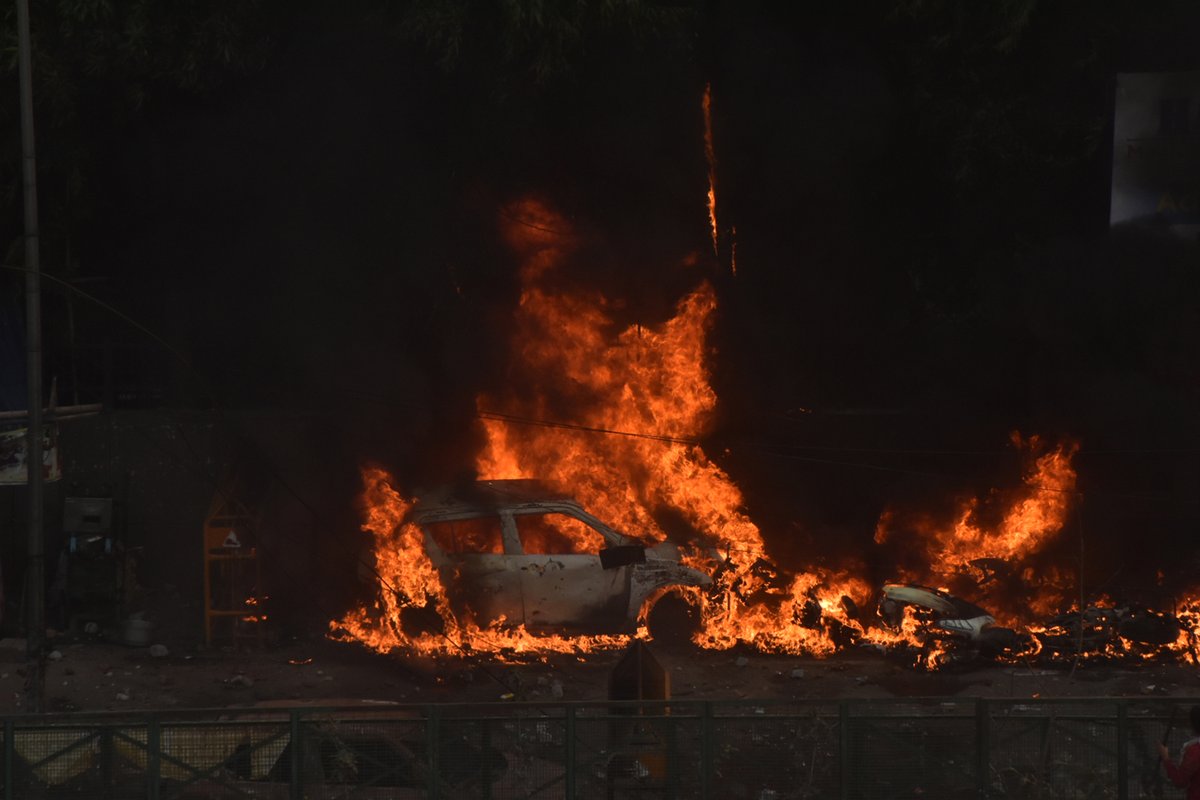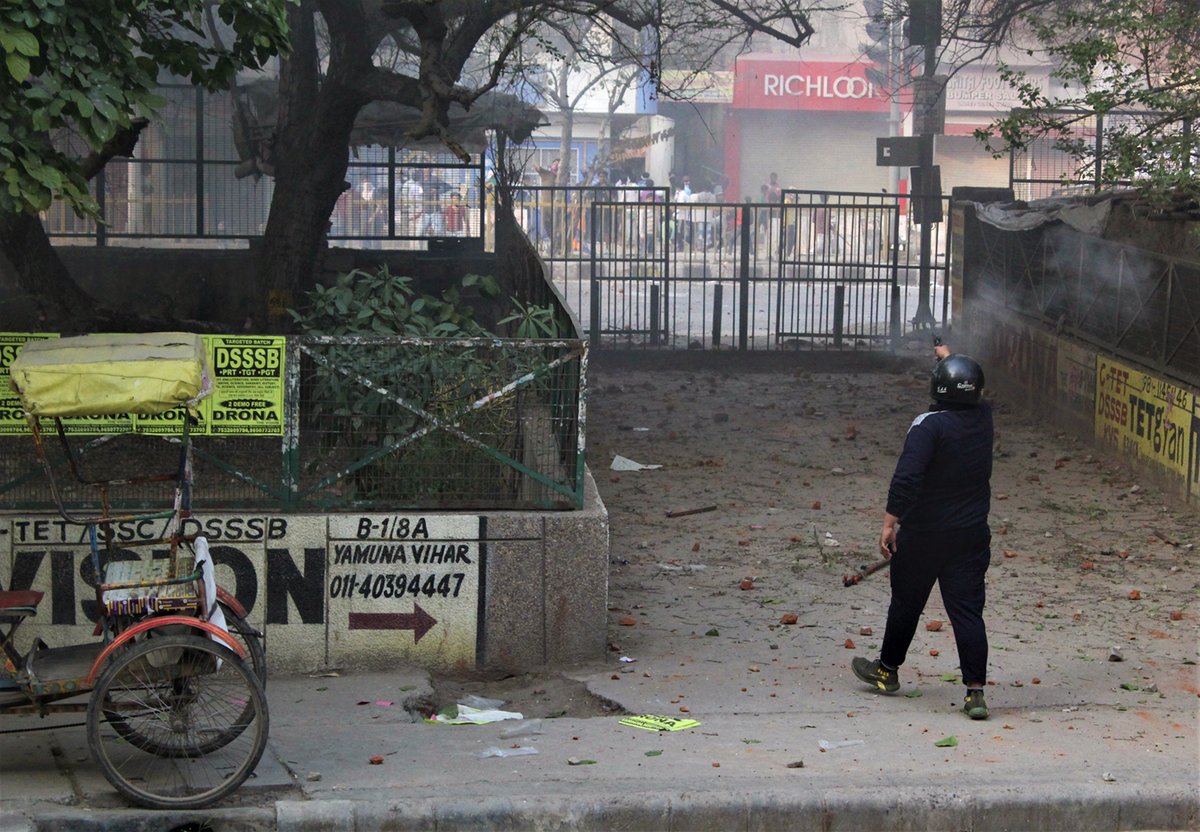
#DelhiViolence | 23 Feb marks two years since anti-Muslim violence unfolded in northeast Delhi.
Here is a master thread of our coverage—ground reports, testimonies of survivors and in-depth investigations into the BJP and the Delhi Police’s complicity in the violence.
Here is a master thread of our coverage—ground reports, testimonies of survivors and in-depth investigations into the BJP and the Delhi Police’s complicity in the violence.

On 23 Feb 2020, a clash between a Hindu mob that gathered at Maujpur and anti-CAA protesters, who had occupied the road at the Jafrabad metro, marked the beginning of over three days of communal violence in the national capital.
@sagar_reporter: bit.ly/2O4UAXf
@sagar_reporter: bit.ly/2O4UAXf

The then deputy commissioner Ved Prakash Surya’s passive demeanour next to BJP leader Kapil Mishra seemed to send a clear message—the latter’s threats of violence had the support of the Delhi Police. #DelhiViolence
@Prabhtalks reports: bit.ly/2YpWm7Y
@Prabhtalks reports: bit.ly/2YpWm7Y

On 24 Feb 2020, “The Hindu mob started stone pelting at the protesters. Then, the mob burnt the petrol pump … Then, all the cars that were there … near the petrol pump—they burnt all of them … The mob started shooting with guns at around 4 pm.”
bit.ly/3dEvcCm
bit.ly/3dEvcCm

#DelhiViolence | @sagar_reporter spoke to stick-wielding CAA supporters at Babarpur. “They had no idea about the law and said they were out on the street because they did not like the ‘Muslim’ anti-CAA protesters of Jaffrabad and Shaheen Bagh.”
bit.ly/2TEHD6T
bit.ly/2TEHD6T
On 24 Feb 2020, after half an hour of stone pelting at the Wazirabad road, a Hindu mob and policemen charged at Muslim protesters with a united cry of “Jai Shri Ram.”
#DelhiViolence
bit.ly/2vizxHw
#DelhiViolence
bit.ly/2vizxHw
By 6 pm, the mob and the Delhi police were bolstered by hundreds of Hindu rioters who descended on Wazirabad road. It was unclear where they came from, but it appeared they had broken through barricades to join the fight against the Muslim protesters.
bit.ly/2vizxHw
bit.ly/2vizxHw

“On the road, I could see members of a mob, armed with sticks and iron rods. I gathered courage and passed through them. Throughout that walk, I kept trying to conceal my beard with my hands.”
From 25 Feb 2020, Parijat P’s five hours in northeast Delhi: bit.ly/39byWGs
From 25 Feb 2020, Parijat P’s five hours in northeast Delhi: bit.ly/39byWGs
Residents of Subhash Mohalla, on 25 Feb 2020, mobs chanting “Jai Shri Ram” tried to enter the block and burnt shops and homes belonging to Muslims. The residents called the Delhi Police for help, but to no avail.
#DelhiViolence
@DharaShukoh: bit.ly/2vX1vsQ
#DelhiViolence
@DharaShukoh: bit.ly/2vX1vsQ
On 24 Feb 2020, a mob attacked a 23-year-old named Salman, with acid. He was brought to the Al Hind hospital. According to Dr MA Anwar, Salman was among “500–600” patients who had been admitted to the 15-bedded hospital between 24 and 26 Feb 2020.
bit.ly/38WBXcG
bit.ly/38WBXcG
On 25 Feb, residents of Jaffrabad and New Jaffrabad had a face off with the police. “I was inside the New Jaffradbad colony, when a young man … semi- conscious, was brought with what appeared to be pellet shots to his eyes and face,” Ishan Tankha said.
bit.ly/2ypj99x
bit.ly/2ypj99x

On 25 Feb 2020, Saleem Kassar watched helplessly as a mob shouting pro-BJP slogans shot his brother twice and tied a bomb to his leg. After the assailants ran for cover, “the bomb exploded and my brother’s body parts flew into pieces,” he said.
bit.ly/31Upp5E
bit.ly/31Upp5E
On 25 Feb, after beating up the men inside the Farooqia Masjid, uniformed men set everything on fire in the mosque. “They had petrol, diesel in plastic bags. They spilled it on the walls, on beddings … then they lit it on fire,” Tahir, the imam, said.
bit.ly/338xIcN
bit.ly/338xIcN
Walking past the charred remains on 26 Feb 2020, it was evident that only the Muslim houses and establishments had been targeted. Only those buildings with visible markers indicating the identity of their owners had been set on fire.
@sagar_reporter in: bit.ly/2OSdjWi
@sagar_reporter in: bit.ly/2OSdjWi
Shaukat Ali Mirza, a resident of Mustafabad, pointed out that the anti-CAA protests had not caused trouble to any religious communities. “Our fight is not with our Hindu brothers,” he said. “Our fight is with the government.”
From Feb 2020, @rag_ps in: bit.ly/2VxLDqY
From Feb 2020, @rag_ps in: bit.ly/2VxLDqY
On 26 Feb 2020, many Muslim locals displaced from their homes moved to Al Hind, a hospital that was already facing an influx of more patients than it had the medical or physical infrastructure to support, ever since the violence began.
@DharaShukoh in: bit.ly/2I8hpTA
@DharaShukoh in: bit.ly/2I8hpTA
Every Muslim resident of Khajoori Khas, even those @sagar_reporter met in neighbouring areas, believed journalists were demonising Muslims even while the evidence showed of targeted destruction of Muslim houses and shops.
bit.ly/2IhsQIS
bit.ly/2IhsQIS
Four photojournalists documented the scenes of despair they witnessed at the hospitals in the aftermath of the large-scale violence in northeast Delhi on 24 and 25 Feb 2020, as the violence escalated and mobs began firing at and beating Muslims.
bit.ly/2PuwLpz
bit.ly/2PuwLpz

.@sagar_reporter interviewed residents, and social activists and lawyers who had been helping the victims of the communal violence since 26 Feb 2020. Almost all of them told said the crime branch was detaining and arresting Muslim men in large numbers.
bit.ly/2vZM9Uv
bit.ly/2vZM9Uv
The Delhi Police ignored complaints against BJP leaders—Kapil Mishra, Satya Pal Singh, Jagdish Pradhan, Nand Kishore Gujjar, and Mohan Singh Bisht—accusing them of participating in or orchestrating the #DelhiViolence.
@Prabhtalks reports: bit.ly/315QBOz
@Prabhtalks reports: bit.ly/315QBOz
Numerous complaints filed by residents of northeast Delhi accuse senior police officials of participating in or encouraging targeted violence against Muslim residents of the region during the violence that swept the city in February 2020.
@Prabhtalks: bit.ly/2YpWm7Y
@Prabhtalks: bit.ly/2YpWm7Y
The media coverage on explosives used in the Delhi violence focused on those discovered on the roof of Tahir Hussain’s house. But numerous complaints filed before the Delhi Police accused Hindu mobs of using explosives openly and without fear.
bit.ly/31Upp5E
bit.ly/31Upp5E
The February 2020 #DelhiViolence was preceded by years of stigmatisation of Indian Muslims, stoked by Hindutva forces organised around the BJP’s ideological parent, the RSS.
@Prabhtalks and @ArshuJohn in the September 2020 cover story: bit.ly/3jCJ2oG
@Prabhtalks and @ArshuJohn in the September 2020 cover story: bit.ly/3jCJ2oG
In a six-month-long investigation, @sagar_reporter scrutinised Facebook live broadcasts by members affiliated to the RSS and the BJP ahead of the #DelhiViolence, and reports on the Hindutva mobilisation that preceded the violence.
Read part one: bit.ly/2O4UAXf
Read part one: bit.ly/2O4UAXf
.@sagar_reporter’s interviews with members of the Maujpur mob indicated that almost all of them were guided by Modi’s statements in their conviction that the protests against the CAA were anti-Hindu and a Pakistani conspiracy to break the nation.
Part II: bit.ly/3q4uwsC
Part II: bit.ly/3q4uwsC
@sagar_reporter Although the situation on the ground reached a flashpoint only on 23 Feb, the BJP’s political mobilisation around the CAA had begun weeks earlier, as a central theme of its Delhi election campaign.
Read part three of @sagar_reporter’s report: bit.ly/2NOhcLS
Read part three of @sagar_reporter’s report: bit.ly/2NOhcLS
• • •
Missing some Tweet in this thread? You can try to
force a refresh



